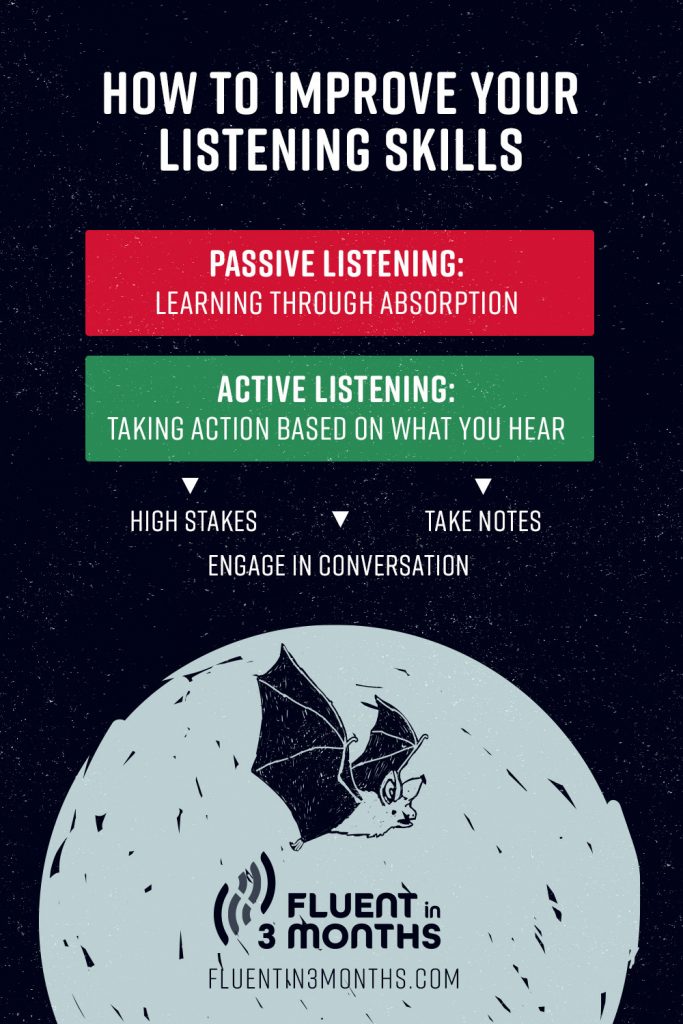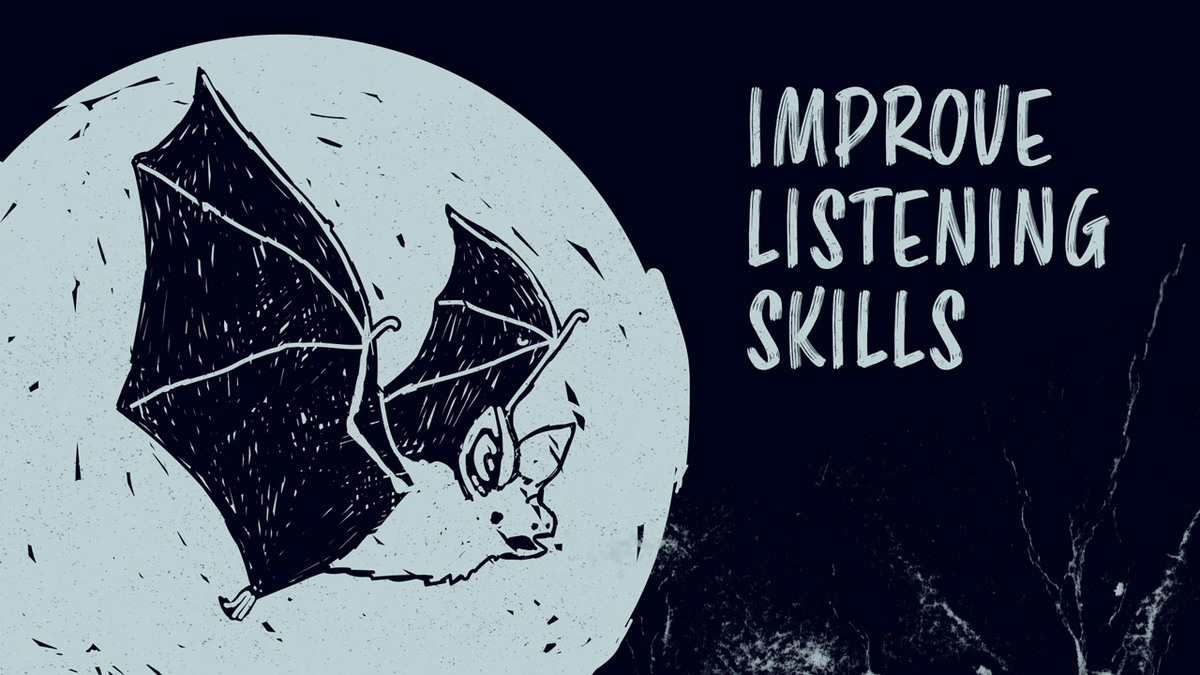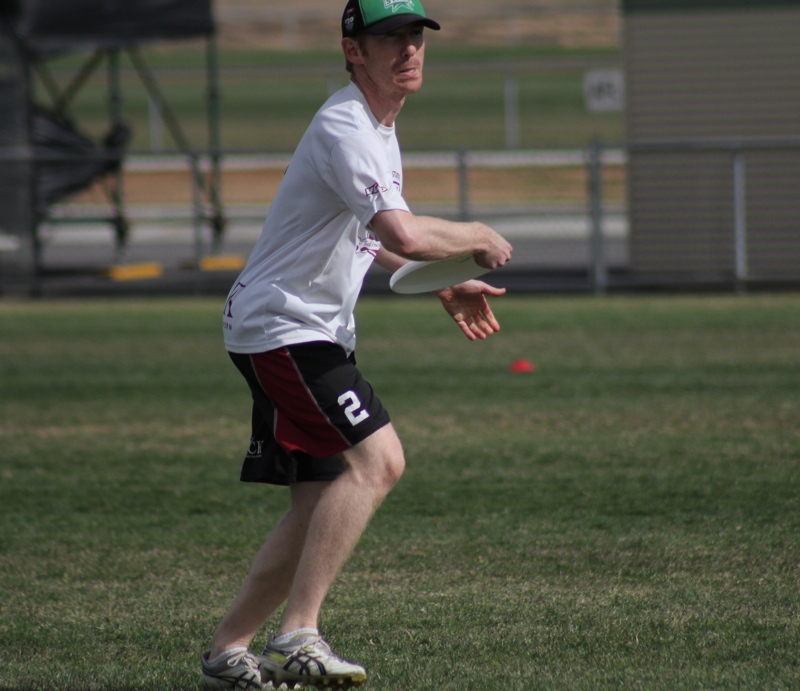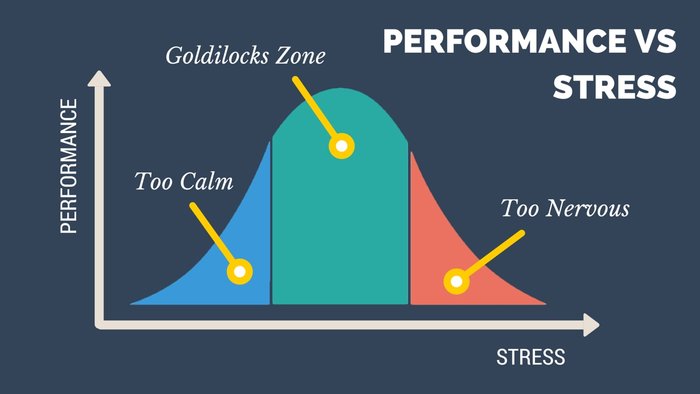How to Improve Your Listening Skills as a Language Learner – an In-Depth Guide
As a language learner, I found listening to be the hardest skill to improve. That might be because I went about it the wrong way.
I sometimes hear other language learners say that, even from the early stages, they understood their target language perfectly fine.
That wasn’t me.
I also hear language learners say that after practicing for a while “it just clicked one day”. After that, they could listen to their target language and understand everything being said.
That also wasn’t me.
Along my language learning journey, developing listening comprehension was a long, slow and painful grind. The adage of two steps forward and one step back comes to mind, but that doesn’t really capture what I went through.
It was more like one inch forward, two steps back, two months pass, half a step forward, then sideways. Basically, it sucked!
In the end, I discovered why I struggled so much with my listening skills: I’d been developing my listening skills in the wrong way.
In this post, you will learn the one activity most students use (including myself) in an attempt to improve their listening skills. I’ll explain why it doesn’t work, and give three other activities that are far more effective for improving your listening skills.
Table of contents
- My Scariest Day in Language Learning
- The #1 Listening Mistake Most Language Students Make
- Performance vs. Stress: What You Need to Know to Achieve the Best Work Productivity
- The Most Effective Way to Improve Your Listening Skills
- Another Solution: Low Stakes Active Listening
- How to Improve Your Listening Skills with Activities Other than Listening
- Listening Skills: Pulling It All Together
If, like me, you've ever felt overwhelmed by listening to your target language, there are steps you can take to solve the problem.
Before I dive into these strategies, I’d like to tell you about a painful moment I will never forget…
My Scariest Day in Language Learning
It was day one of a four-week stay in Madrid that I had planned to work on my Spanish.
I had signed up for a Spanish school. On the first morning, they made me take a placement test to work out which class I should be in.
My reading, writing and spoken Spanish were good. After the test, they put me into a class at level B2.
Later that morning, I joined my new class. From the very first minute, I was lost.
The teacher — speaking only Spanish — whizzed through some complicated grammar structures that I had never seen before. I was straining to keep up.
I wanted to say “I quit” and walk out of the classroom.
Instead, I pretended to understand and asked a question or two based on what I read in the book. You know, to avoid any unwanted attention.
After two hours of intense grammar, I wasn’t the only one who was drowning in information overload. The teacher picked up on the lack of student presence and said something like:
Ya hemos hecho bastante gramática por hoy. Vamos a jugar un juego que se llama el “teléfono roto”. (“Now we have done enough grammar for today. We are going to play a game called ‘broken telephone’.”)
¿¡¿Teléfono roto?!?
“Do you know what it is?” I asked the Italian girl next to me.
She shrugged.
Soon enough, with a quick visual demonstration from the teacher. I realised we were about to play ‘Chinese Whispers’ (Telephone) in Spanish.
My heart rate soared and I could feel my stomach bottom out.
The teacher was planning to whisper something in the first student’s ear. This would then get passed from student to student until the last student read out the final message.
I was the last student.
I’m Sure You Could Imagine What Happened Next — It Didn’t Go Well
I was the only student who couldn’t make out the message. Everyone was waiting for the fun of the final message to be announced. I couldn’t say a word.
The teacher said that the girl next to me could break the rules and whisper the message again. I still couldn’t make out a word.
I felt like a fraud. Like I shouldn’t have been in that class.
I felt like I had let everyone down.
Despite this emotional experience, I didn’t want to quit. It was horrible, but afterwards, I was determined that next time I would be able to pull my own weight.
Next time, I wouldn’t be the weakest telephone!
I told you this story for two reasons. Firstly, because even when it feels like things are really bad, they aren’t that bad. I was only embarrassed in front of other language students.
Secondly, stress plays a very important part of performance and improvement. More on this later.
The #1 Listening Mistake Most Language Students Make
When I first started learning a second language, it didn’t take long to realise how difficult it was to improve my listening skills.
I tried watching movies without subtitles, with subtitles in my own language, subtitles in the target language. I tried listening to podcasts and I watched the Spanish news every Saturday morning.
Even when I knew what was being said, by following along with movie subtitles or an audio transcript, the sounds I was hearing weren’t connecting with the words I understood on paper.
I thought maybe the answer was more listening. So I did just that — I listened for hours.
The problem was, even after hours of listening, I still wasn’t improving.
After a few years of studying the language in my own country, it wasn’t until I went on a trip to Spain that I realised what the problem was…I had fallen into the passive listening trap.
It wasn’t until I had spent time using the language and interacting with locals that I realised that my passive listening was the reason I hadn’t made any significant progress.
What Is Passive Listening?
With passive listening, you simply listen to a recording of your target language or watch a movie. The idea is that even though you don’t understand it now, over time you will start to understand more and more through a natural process of absorption.
The problem is… it doesn’t really work.
Students often fall for the idea of passive listening because many language programs are based on the practice. These programs suggest that you can improve your listening skills while doing the dishes, driving to work or even while sleeping.
It is also such an alluring concept, learn a language while you sleep. It doesn’t get more enticing than that!
Sadly, like most ideas that promise maximum results with minimum effort, it rarely delivers.
Why does passive listening fail? To answer that question, you need to learn a thing or two about performance and stress.
Performance vs. Stress: What You Need to Know to Achieve the Best Work Productivity
I have a confession. Whenever I’m not working on my language skills or helping my students with theirs, I’m watching or playing sports. I love sports! I’m just as obsessed about sport as I am about languages.
Even if you aren’t a fan of sports, you can still take advantage of a valuable lesson I was given by a respected coach while playing Ultimate Frisbee.
The idea is simple. It’s called the Performance-Stress Curve.
What the curve illustrates is that there is an “optimum” level of stress for maximum performance.
If you aren’t nervous, or you are too nervous, your performance won’t be as good as when your level of nerves is just right. You could call it a “Goldilocks” level of stress.
When I was in the Spanish school playing teléfono roto, I was way too stressed. I was well beyond the point of optimal performance. I could barely function, let alone focus on the sounds of a language that wasn’t my first.
The reverse situation is passive listening. If you are listening to a recording or watching a movie, it is simply way too easy to lose focus. When you are feeling relaxed and your stress levels are low, your performance and your ability to improve will drop away.
When you are listening passively, there is nothing on the line. There is no consequence for not understanding what you have heard.
Passive listening doesn’t work because there isn’t anything to push you to improve. If you want to improve your listening skills, you need to have something that forces you to concentrate and focus.
In order to develop a new skill that you have never had before, you need to introduce some stakes into the game.
The Most Effective Way to Improve Your Listening Skills
The most effective activity for improving your listening skills is something I call “high stakes active listening”.
Active listening, by definition, is an activity that requires you to listen to something and take action based on what you have heard.
Active listening is separated from passive listening by the simple requirement that you have to do something in response to what is entering your ears. This change causes you to move up the Performance-Stress curve from your baseline.
But it isn’t enough to just actively engage.
If you want to start getting into the “Goldilocks” area of stress, where your performance and rate of learning is the highest, you need to have some stakes on the line.
One of the best forms of high stakes active listening is speaking with a native in a one-on-one situation.
Speaking in a one-on-one situation is miles ahead of passively listening to a recording. It forces you to concentrate and be actively engaged in the dialogue.
I remember vividly one critical encounter that opened my eyes to the power of high stakes active listening when I was trying to find parking in Madrid.
My girlfriend and I entered an undercover parking garage. There were no signs explaining opening times or prices for parking.
We drove up to the parking attendant window and I asked in Spanish: “How much to park the car?”
The attendant responded 12 euros al día (“12 euros per day”).
Good start.
I then asked “What time do you close?”
That question was followed by an onslaught of Spanish that went straight in one ear and out the other.
Our accommodation for the night was over an hour away. We were afraid that if the parking garage closed while we were out late in the city, we would be stuck there until morning.
I had to find out when they closed.
If the car got stuck for the night my girlfriend would never have forgiven me. The stakes were officially high!
Over the next fifteen minutes, I asked a series of questions. Most of them were followed by a torrent of information that I struggled to put together. But after fifteen minutes, the ideas that the parking attendant was throwing at me started to take shape.
In the end, the message became clear. The parking lot was open 24 hours a day. If we stayed past midnight they would charge us for a second day.
Hallelujah. ¡Genial!
I got the message. And better yet, I learned more about the process of improving listening comprehension skills in that fifteen minutes than I did all the way up until that point.
From then on, I have always looked to practice my listening skills with a native in a one-on-one situation.
Another great way to find this type of practice is in a language exchange. Language swaps are perfect for forcing active engagement. Especially if you meet someone new and you want to make a good first impression.
There are a number of resources you can use to find a language swap, no matter where you live.
It may sound scary to speak with someone if, up until that point, you haven’t really understood your target language yet. But do not underestimate the progress you can make with this type of practice.
Another Solution: Low Stakes Active Listening
I’ll admit there are two potential problems with practicing in high stakes active listening scenarios:
- Sometimes, language exchanges are hard to find and schedule. That’s especially true if you aren’t living in a country where you can find native speakers of your target language. Or in one where you might have timezone issues for a Skype conversation.
- A high stakes active listening scenario could push you into the red zone of performance if you are just too nervous to practice.
If you are struggling with problem number two, I encourage you to just give it a go. Nerves subside after you try something once.
I personally know the fear that comes with looking silly, I pointed it out at the start of the post. But it does get easier when you try it more often.
See if you can find someone you trust who speaks your target language. Or alternatively, to start with, you might like to practice with someone you know you will never see again. This is what I did with the parking attendant.
If you have problem number one, then you need to find active listening challenges that don’t involve another person.
These types of activities I call “low stakes active listening”.
Low stakes active listening activities are better than passive listening because they still require you to actively engage in the training materials. These types of activities can’t be done while doing something else, like driving to work.
Examples of this type of training include software courses and apps.
Duolingo includes simple active listening exercises that require you to answer questions and solve puzzles in response to a short audio clip.
If you can’t find software courses in your target language, then, where possible, make an active game out of an audio recording that would typically be used for passive listening.
Rather than listen to a podcast in the car, listen to it at your desk with a pen and piece of paper and start transcribing what you hear.
Write down what you do understand. See if you can fill the holes by guessing the missing information from context. Or try listening to a short section of the audio a number of times to fill in the blanks.
This type of training isn’t as effective as high stakes active listening, but it will take you much further in a short period of time than passive listening alone.
How to Improve Your Listening Skills with Activities Other than Listening
There are two main reasons people struggle with listening:
- You can’t connect the sounds of the language to words that you know on paper. This could be due to the speed of the speaker, their accent or simply a lack of high stakes active practice.
- You can make out the sounds of the language and you can connect those sounds with words, but you just don’t know what the words mean. This could be because you don’t know enough of the language yet.
If you have spent a lot of time buried in books with your target language, chances are you are struggling because of reason number one. You need to put yourself in more high stakes active listening scenarios or, at least, spend more time doing low stakes active listening activities.
In other words, you need to put yourself in situations where you can develop your ear as effectively as possible by increasing the stakes (use techniques above).
Alternatively, sometimes the reason language learners struggle with listening comprehension is because they simply haven’t developed vocabulary or grammar in their target language.
When I was first starting to learn a second language, I remember putting on movies in my target language without subtitles. And I would think, “This is impossible, I’ll never be able to learn this language.”
But this was bad feedback. The fact that I couldn’t understand movies had nothing to do with my potential to learn the language.
What I realised later was, when I turned on subtitles or followed audio with a transcript, I didn’t actually recognize the words I was listening to on paper. I needed to improve my knowledge of the language in general.
No amount of passive listening was ever going to solve this problem.
The best way to solve this problem was to simply do more study without listening.
I felt much more at ease if I turned off the movies and sat down with a book. Or if I spent time on a beginner-focused language learning website. I could feel good again about my progress as I added new words and grammar to my knowledge of the language.
After sufficient time studying the language, I could return to the audio with accompanying transcripts knowing that I could at least understand the words on paper. Once I was at that point, I could use the high stakes active strategies to increase the rate my ear could get used to the sounds.
Listening Skills: Pulling It All Together
Apart from being ineffective, passive listening practice can be a source of frustration that, in an absolute worst-case scenario, could cause you to give up your language studies altogether.
At best, passive listening is great for demonstrating that you have made progress using other, more effective, listening techniques.
If you really want to accelerate your listening comprehension skills:
- Put yourself in high stakes active listening situations. See if you can use your most powerful weapon for performance — stress — to increase your rate of learning.
- Spend more time actively engaged with software tools and apps, or podcasts and movies with pen and paper in hand.
- Use non-listening activities like reading to boost your vocabulary.
No matter if you think you have a disadvantage with listening skills, you can improve as long as you are spending time doing the right kinds of effective practice.

Original article by Andrew Barr, updated by the Fluent in 3 Months team.






Social